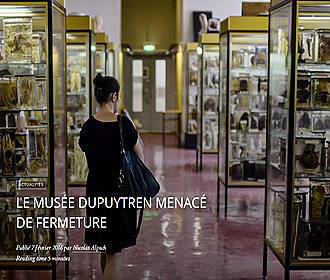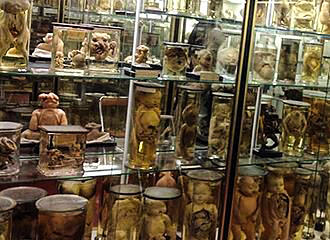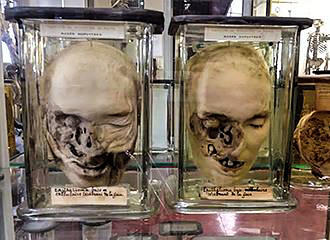Paris Musee Dupuytren Museum
The Paris Musee Dupuytren is an unusual Paris museum that deals with anatomic pathology and showcases many different malformations of the body along with skeletons, bones, paintings, drawings and some tools that were used in the pathology practise, but is now closed to the public and only open for research projects by prior appointment.
Musee Dupuytren history
Now, the Paris Musee Dupuytren was first founded back in 1835 by Mathieu Orfila who founded toxicology, after a bequest from Guillaume Dupuytren, who was the professor of medicine at the surgical faculty of medicine in Paris, which hence the name given to this museum in Paris.
It was decided to installed this museum within the Refectoire des Cordeliers refectory of the old convent, then was filled with skeletons, wax moulds, organs preserved in jars and much more that included many malformations of the human body, which were considered as monstrosities for many years.
It was decided to install this museum within the Refectoire des Cordeliers refectory of the old convent, then it was filled with skeletons, wax moulds, organs preserved in jars and much more that included many malformations of the human body, which were considered as monstrosities for many years.
It was between the years of 1836 and 1942 that the first catalogue was produced itemising around 1000 different specimens and by the 1870s this had accumulated immensely to a few thousand items.
However, by the start of the 1900s the Paris Musee Dupuytren museum had started to slowly decline and with the Cordeliers building itself falling into a dilapidated state, the museum was closed in 1935 and the items were all removed and placed within the basement of the faculty.
Unfortunately, because of this, many items suffered major damage and lots of the original itemisation details were also lost and it was not until 1967 that this Paris museum was to be given a new lease of life.
After renovations of the Refectoire des Cordeliers and relocating and documenting the items, the Paris Musee Dupuytren Museum was re-opened to the public at the Cordeliers School of Medicine Centre in Paris, which is where it still remained until 2016.
About the Paris Musee Dupuytren
This museum now contains around 6000 different objects including wax anatomical models with the oldest dating from the 18th century that are remnants from the collections of the Royal College of Surgery.
There are also thousands of pieces of bone that range from complete skeletons and skulls through to bone fragments and joints that portray different lesions and malformations that are uncommon in the West, yet still can be found in underdeveloped countries.
There are also numerous paintings, prints and drawings, plus the Paris Musee Dupuytren museum also contains the brains of aphasic patients that were preserved in jars by the famous anatomist Paul Pierre Broca, and having much historical importance, these were used in his research into the localisation of brain functions.
Another section at this museum was from the Dejerine Foundation after the bequest of Jules Dejerine who was professor of neurology at the Medical Faculty in Paris where, along with his wife Augusta Dejerine-Klumpe who was the first woman intern at a Paris hospital, developed his symptomatology of the nervous system. And this section contains his library, microscopes, tools and different instruments along with the histological preparations and photographs that he used.
So, as you can tell, this is a very unusual museum and is a fascinating place for anyone interested in human biology, pathology, neurology and is a fascinating look back at the history of medicine, anatomy and bodily malformations.
Access to the Paris Musee Dupuytren
Now, the Paris Musee Dupuytren closed its doors to the public in 2016 and moved from the Refectoire des Cordeliers to the Jussieu Campus to join eight of the Universite Pierre et Marie Curie's scientific collections.
It is now only open for research projects and students of the UPMC, which is the shortened name for the Pierre and Marie Curie University, but only by prior appointment, and is closed at all other times including national French holidays, plus during the school and university holidays.
But if you do manage to get a chance to discover the Paris Musee Dupuytren, then it is located at the Jussieu Campus of the Pierre and Marie Curie University in the 5th Arrondissement of Paris.
When it comes to getting here via Paris public transport, you will find that the nearest Metro station is Jussieu stop serving lines 7 and 10, however, if you are travelling to or from Paris via train, then the Gare d'Austerlitz located on the opposite side of the Jardin des Plantes serves the TER, Intercities and RER trains for the RER C line, plus this is also a Metro station for lines 5 and 10.
Alternatively, if you are travelling on the Paris buses you would need lines 24, 47, 63, 67, 86, 87 and 89 along with the Noctilien Night Bus Service via lines N15 and N22, which will all get you close by to this university and the museum.


